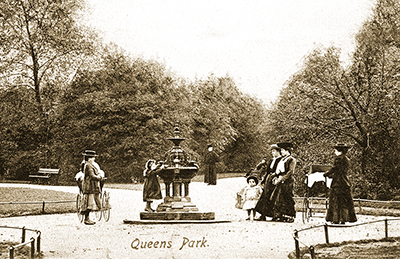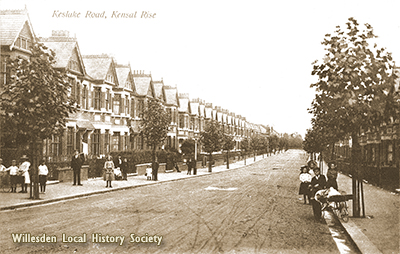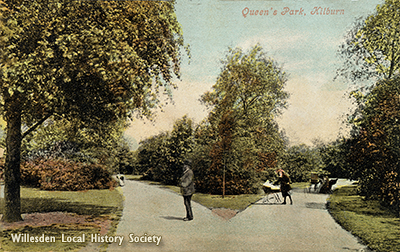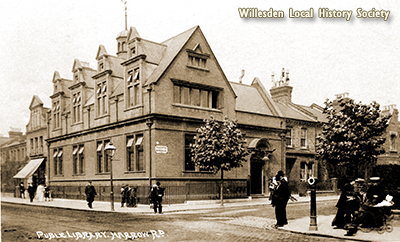
Queen’s Park

The History of Queen’s Park
The Queen’s Park area of Brent lies between Chevening and Harvist Roads on the north and south, and Chamberlayne and Salusbury Roads on the east and west.
Going back to the Ango-Saxons, the area where Queen’s Park now lies was part of Middlesex, which was a large area between the kingdoms of Essex, Sussex & Wessex. In terms of ownership, the land belonged to St. Paul’s Cathedral by the time of the Norman Conquest, being part of the prebend of Brondersbury.
The lands remained largely pasture until the latter half of the 19c. Although the railways came to the area earlier, urban development only started with the opening of stations. On the 2nd of June 1879 the London and North Western Railway opened a station on Salusbury Road, which came to be known as Queen’s Park – on the border of the newly built estate. In 1915 the underground Bakerloo line were extended from Kilburn Park to join the LNWR.
The station opened just in time for the preparation of the Royal Agricultural Society of England’ show, which was to take place in Kilburn in 1879. The aim of the show was to bring new techniques, inventions and agricultural knowledge to farmers. The Kilburn show was to be the largest of its kind ever held, occupying 100 acres, with 650 exhibitors displaying implements and machinery, seedsmen and manure manufacturers, artificial food merchants and prized animals, paraded daily in front of the royal box. It was opened on 30th of June 1879 by the Prince and Princess of Wales, and visited by Queen Victoria on the fifth day. The show ran for a week. Despite attracting 187,000 visitors, the show was not as financially successful as the organises planned – 1879 was one of the wettest summers on record, and visitors struggled through deep mud in torrential downpours.
After the show the landowners, the Ecclesiastical Commissioners, offered 30 acres of the land to the Corporation of London public park will be created. The Corporation of London at first considered the Kilburn site to require more investment and maintenance than they were prepared to afford. The idea of the park was rescued with the help of the bequest of businessman and philanthropist William Ward, who set up a fund for a girls’ school in the City of London, and some funds were left ‘to be applied and expended in the erection and maintenance of some institution and the creation of some fund for the benefit of the poorer classes’. Together with some more funds from grain duties from the Port of London, the Corporation found enough resources to lay out and maintain the park, – as it has been doing to this day.
The park was planned by landscape designer Alexander McKenzie and officially opened on 5th November 1887. It featured two central circular areas for recreation and sport, surrounded by trees and shrubberies, with strategically placed openings to view vistas across the park, increasing its apparent size. Most of the dense planting was removed in the 1960s to help with maintenance costs.
The park also featured a gymnasium and a refreshments lodge. In the 1930s tennis courts and a pavilion were laid out. There was a refreshment building, which was replace by the current 2 storey structure in 1963. In 1966 a nine hole pitch and putt course was laid out in North field, covering covers seven acres of the park.
From early 1900 the park grew its own plants. The two greenhouses provided enough planting material not just for the park, but also for St. Paul’s Cathedral. The greenhouses were demolished in 1970.
There was a drinking fountain at the meeting point of the circular areas, and a park keeper’ lodge in the south eastern corner. The current lodge in the Quiet Garden, and the flowerbeds there are in the same place as the originals – the flower beds are the only remnants of the 6 original formal parterre triangles around the park. The short stroll along the path of the Quiet Garden culminates in the 1936 Lych Gate with seats. It used to be an entrance to the park on corner of Kingswood Avenue and Harvist Road, but was blocked off in 1960.
The most spectacular remnant of the original park architecture is the 1891 bandstand. It was made in cast iron by Macfarlane and Co. of Glasgow. In 1992 it was restored and is now Grade II listed. Another Grade II listed structure is nearby – it is the telephone kiosk tucked away in a little alcove in Harvist Road, by the entrance to the park. It is Type K6, designed in 1935 by Sir Giles Gilbert Scott.
During the Second World War a barrage balloon station occupied part of the South field, and land was dug up for allotments. The attempt to build dugout shelters in the north field did not work out – they became waterlogged. The original creation of the park involved providing drainage, but with 5 natural springs rising within the park’s territory, the nature still takes its course!
In the 1970’s Dutch Elm Disease killed over 180 elms. In 1999 the Woodland Walk was created, in place of the original path destroyed during the Second World War. The Children’s Farm was constructed in 1990, now having a fine selection of goats, water fowl and hens.
In 1973 the Queen’s Park Area Residents Association (QPARA) was set up, to protect the interests of the community when the Council proposed to create a General Improvement Area around the park. Since them the QPARA has played an active role in making the park a favourite place for the local community, with many large scale events throughout the year, such as outdoor film screenings, Christmas Gathering, Queen’s Park Day and Queen’s Park Book Festival.
The housing around Queen’s Park is within a conservation area. As well as the two Grade II listed structures – the bandstand and the telephone kiosk, the only other listed building is the Stone Hall in Chevening Road. It is locally listed by Brent. Built in 1904 as a synagogue, it is now an Islamic Centre.
Most houses around Queen’s Park were built between 1897 and 1904. Many of the names reflect historic connections. Edward Harvist, a rich 17th century businessman, left a legacy for the maintenance of Edgware Road. Today the Edward Harvist Trust Fund is a charity which gives grants for community projects in Westminster, Brent, Camden and Harrow. Thomas Keslake was a local builder. Chevening is the estate near Sevenoaks then owned by the Earl of Stanhope, Chairman of the Ecclesiastical Commissioners. The Rev. J E Kempe was Prebendaries of St Paul’s. Henry Hart Milan was a historian, dramatist, professor of poetry at Oxford, Dean of St. Paul’s. He is buried in St.Paul’s Cathedral.
Mandell Creighton was a historian and Bishop of London. He was interested in education. Under his patronage the choir school at St. Paul’s Kilburn was transformed into Kilburn Grammar School in 1897. From 1900 the school was in Salusbury Road, and, later merging with the Brondesbury and High School for Girls nearby, became Brondesbury and Kilburn High School in 1972, and in 1989 became part of Queen’s Park Community School.
Amongst notable residents of Queen’s Park were Richard Baker OBE, a newsreader for the BBC between 1954 and 1982 – he lived in Kingswood Avenue and went to Kilburn Grammar School. Author Barbara Pym, also a local resident at one time, set her novel Unsuitable Attachment in the Queen’s Park area.
In recent years famous Kensal Rise/Queen’s Park residents included singer Lily Allen, Jade Jagger, model-turned-author Sophie Dahl and her fiancé Jamie Cullum, author Zadie Smith Daniel Craig and his wife Rachel Weisz, actress Thandie Newton, actor Mark Strong, Eddie Izzard, Dermot O’Leary, Louis Theroux, designer Phoebe Philo – you never know whom you bump into in our lovely park these days!
Irina Porter – May 2021
More information is in Journal 53, and in the talk In and Around Queen’s Park, available from the Archives pages of the website.



